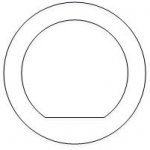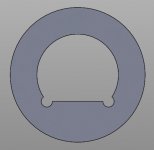The Dude
Hot Rolled
- Joined
- Oct 19, 2010
- Location
- Portland, OR
We don't machine metal parts for our customers, those parts are always farmed out and we do the end assembly. Got a new preliminary design from a customer and their "hub" is fairly standard (has an ID, OD, a flange with boss, set screw) but the ID has a flat in it  . My machining knowledge tells me this will be rather difficult to achieve. Volumes are low so any investment casting, even if accurate enough, is out of the question (as is laser cutting the ID). Outside of broaching (which would require a customer broach), is there any other means of getting a flat on the inside? Material is stainless 316 and the nominal ID is 48 MM and the flat is at a radius in the center of the flat at 23 MM. The hub bore is 8.5 MM thick.
. My machining knowledge tells me this will be rather difficult to achieve. Volumes are low so any investment casting, even if accurate enough, is out of the question (as is laser cutting the ID). Outside of broaching (which would require a customer broach), is there any other means of getting a flat on the inside? Material is stainless 316 and the nominal ID is 48 MM and the flat is at a radius in the center of the flat at 23 MM. The hub bore is 8.5 MM thick.
My only though is to machine out the bore but I'm not even experienced enough to know what tools to use to carve out the inside of the hub or if this could be done on a CNC lathe with live tooling. I guess that's why I'm asking here!
Update: here's a simple diagram of what they want:

Thanks,
The Dude
 . My machining knowledge tells me this will be rather difficult to achieve. Volumes are low so any investment casting, even if accurate enough, is out of the question (as is laser cutting the ID). Outside of broaching (which would require a customer broach), is there any other means of getting a flat on the inside? Material is stainless 316 and the nominal ID is 48 MM and the flat is at a radius in the center of the flat at 23 MM. The hub bore is 8.5 MM thick.
. My machining knowledge tells me this will be rather difficult to achieve. Volumes are low so any investment casting, even if accurate enough, is out of the question (as is laser cutting the ID). Outside of broaching (which would require a customer broach), is there any other means of getting a flat on the inside? Material is stainless 316 and the nominal ID is 48 MM and the flat is at a radius in the center of the flat at 23 MM. The hub bore is 8.5 MM thick. My only though is to machine out the bore but I'm not even experienced enough to know what tools to use to carve out the inside of the hub or if this could be done on a CNC lathe with live tooling. I guess that's why I'm asking here!
Update: here's a simple diagram of what they want:

Thanks,
The Dude


